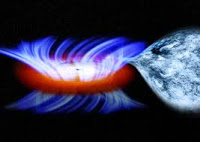The notion of the speed
of light as the cosmic speed limit is based on the assumption that particles of
light, called photons, have no mass. But astrophysical observations cannot rule
out the slim chance that photons do have a tiny bit of mass—a prospect with
wide ramifications in physics. For instance, if photons weigh nothing at all,
they would be completely stable and could theoretically last forever. But if
they do have a little mass, they could eventually decay into lighter particles.
Now, by studying ancient light radiated shortly after the big bang, a physicist
has calculated the minimum lifetime of photons, showing that they must live for
at least one billion billion years, if not forever.
That lifetime may sound
like an eternity, but to a photon traveling at light speed, it passes in a
relative blink. Because of the time-dilation effect predicted by Einstein's
special theory of relativity, a billion billion years on Earth feels like only
three years to a photon, because it's traveling so fast.
If physicists ever do
discover that photons have nonzero mass, and therefore limited lifetimes, then
“the notion of light-speed obviously wouldn't make much sense anymore,"
says study author Julian Heeck, a PhD student at the Max Planck Institute for
Nuclear Physics in Heidelberg, Germany." There would still be an absolute
limit on velocities, but the photons would have to obey that law, too, and
travel below the speed of light." Photons’ speed would then depend on
their wavelengths, and blue light would travel faster than red light. Photons
released simultaneously from distant stars would arrive at Earth at different
times, depending on their wavelengths.
A photon with mass
would also necessitate modifications to the Standard Model of particle physics
(which posits a massless photon), the Maxwell equations that describe
electromagnetic waves and fields (photons are the carrier particles for
electromagnetic force) and the laws describing interactions between charged
particles. Because of this latter effect, observations of the sun’s magnetic
field have already proved that the photon, if it weighs anything at all, must
be extremely light. The current experimental limit on the possible mass of the
photon is 10-54 kilogram.
To find the limit on
the photonic lifetime, Heeck analyzed observations of the cosmic microwave
background radiation—light pervading the universe that dates from a few hundred
thousand years after the big bang—gleaned from the now defunct NASA's Cosmic Background
Explorer (COBE) satellite, launched in 1989. This light fits a very specific
pattern—called blackbody radiation, that tells scientists how intense the light
should be, based on its wavelength. If any photons were decaying as they
traveled across the universe, however, COBE would see less low-energy (redder)
light than predicted by the blackbody radiation law, because red light would be
expected to decay sooner than blue light. "If the photons come from very
far away, say from the beginning of the universe, then they might have had
enough time to decay on their way here," says physicist Emanuele Berti of
the University of Mississippi, who has studied the mass of the photon but was
not involved in Heeck's research. "That's the idea, which I think is very
elegant."
But according to COBE's
measurements, the cosmic microwave background appears to behave like a perfect
blackbody. No low-energy light seems to be missing, indicating that very few
photons, if any, have decayed since the big bang some 13.7 billion years ago.
This analysis enabled Heeck to calculate that the minimum lifetime of a photon
is 1018, or one billion billion, years.
Although the simple
model of a massless photon may turn out to be correct, the prospect of one with
mass raises some intriguing possibilities. For instance, if photons do decay,
what do they decay into? "That's, of course, the key question," Heeck
says. One possibility are particles called neutrinos, which come in several
varieties, or flavors: "If the lightest neutrino were massless, then that
would be the most obvious final state" for the photon, Heeck says. A
photon "could also in principle decay into other unknown particles."*
Heeck's paper,
published July 11 in Physical Review Letters, represents the first calculation
of the minimum lifetime of a photon, but it relies on some simplifying
assumptions, he says. Most important, it neglects interactions of photons and
matter after the cosmic microwave background formed, which could have a strong
effect if photons have very small masses. For example, photons may be absorbed
by interstellar matter and reemitted, changing their properties. Berti agrees
that the assumptions complicate things. "The calculation in principle is
very interesting," he says. "But then the devil is in the
details."
If these matter
interactions can be better understood and taken into account, Heeck says he
could calculate tighter limits on the photon’s lifetime. More precise data
about the cosmic microwave background would also help, although the reason
Heeck didn't use measurements from more recent spacecraft than COBE, such as
the Wilkinson Microwave Anisotropy Probe, is because those newer observations
lack the necessary temperature data to understand the light's blackbody
spectrum.
Source: Yahoo news.





No comments:
Post a Comment